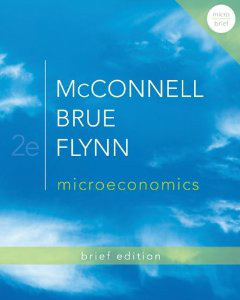Principles of Microeconomics

Textbook: Microeconomics (Brief Edition), by McConnell, Brue, and Flynn, McGraw-Hill Irwin, 2012. ISBN: 978-0077416201
Using the Online Learning Center (.pdf)
Use the OLC for access to PPT slides, videos, quizzes, study guides, and other
important chapter-by-chapter information.
Register for McGraw-Hill Connect
Using the Online Learning Center (.pdf)
Use the OLC for access to PPT slides, videos, quizzes, study guides, and other
important chapter-by-chapter information.
Register for McGraw-Hill Connect
CHAPTER MATERIAL
Chapter 1: Limits, Alternatives, and Choices
After reading this chapter, you should be able to:
- Define economics and the features of the economic perspective.
- Describe the role of economic theory in economics.
- Distinguish microeconomics from macroeconomics.
- List the categories of scarce resources and delineate the nature of the economizing problem.
- Apply production possibilities analysis, increasing opportunity costs, and economic growth.
- (Appendix) Understand graphs, curves, and slopes as they relate to economics.
|
Chapter 1: PPC
|
Chapter 1: Budget Line
|
Chapter 2: The Market System and the Circular Flow
After reading this chapter, you should be able to:
- Differentiate between a command system and a market system.
- List the main characteristics of the market system.
- Explain how the market system answers the four fundamental questions.
- Discuss how the market system adjusts to change and promotes progress.
- Describe the mechanics of the circular flow model.
|
| ||||||
Chapter 3: Demand, Supply, and Market Equilibrium
After reading this chapter, you should be able to:
- Describe demand and explain how it can change.
- Describe supply and explain how it can change.
- Relate how supply and demand interact to determine market equilibrium.
- Explain how changes in supply and demand affect equilibrium prices and quantities.
- Identify what government-set prices are and how they can cause product surpluses and shortages.
|
|
Video Links:
Chapter 3: The Demand Curve (23 Mb download) Chapter 3: The Supply Curve (21 Mb download) Chapter 3: Equilibrium (40 Mb download) Chapter 3: Curves Shifting (47 Mb download) | ||||
Chapter 6: Businesses and their Costs
After reading this chapter, you should be able to:
- Identify features of the corporate form of business organization that have made it so dominant.
- Explain why economic costs include both explicit (revealed and expressed) costs and implicit (present but not obvious) costs.
- Relate the law of diminishing returns to a firm's short-run production costs.
- Describe the distinctions between fixed and variable costs and among total, average, and marginal costs.
- Use economies of scale to link a firm's size and its average costs in the long run.
|
| |||||
Chapter 7: Pure Competition
After reading this chapter, you should be able to:
- Give the names and summarize the main characteristics of the four basic market models.
- List the conditions required for purely competitive markets.
- Describe how purely competitive firms maximize profits or minimize losses.
- Explain why the marginal-cost curve and supply curve of competitive firms are identical.
- Discuss how industry entry and exit produce economic efficiency.
- Identify the differences between constant-cost, increasing-cost, and decreasing-cost industries.
|
| |||||
Chapter 8: Pure Monopoly
After reading this chapter, you should be able to:
- List the characteristics of pure monopoly and discuss several barriers to entry that relate to monopoly.
- Explain how a pure monopoly sets its profit-maximizing output and price.
- Discuss the economic effects of monopoly.
- Describe why a monopolist might prefer to charge different prices in different markets.
- Identify the antitrust laws that are used to deal with monopoly.
|
| |||||